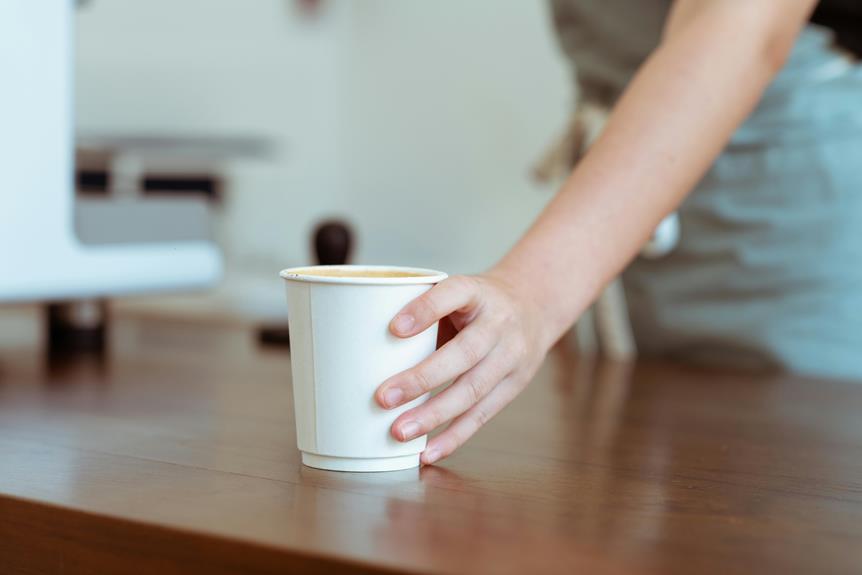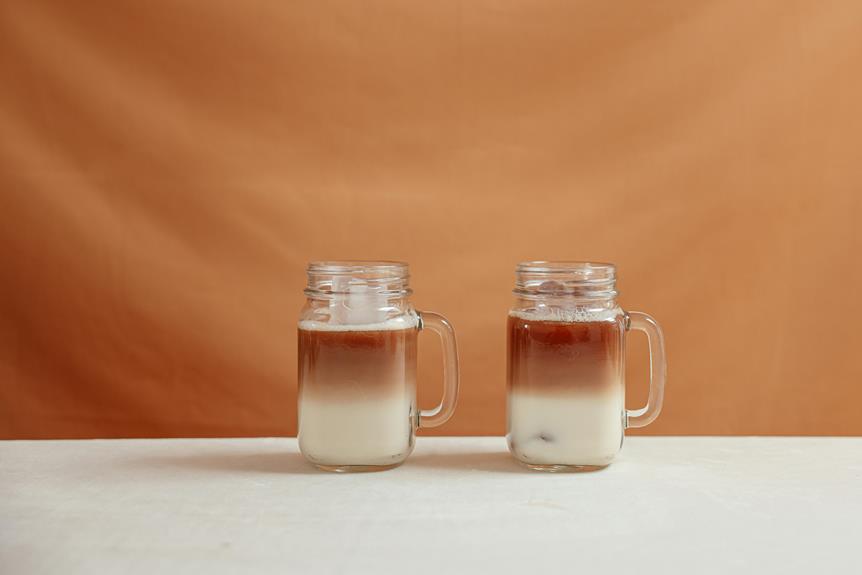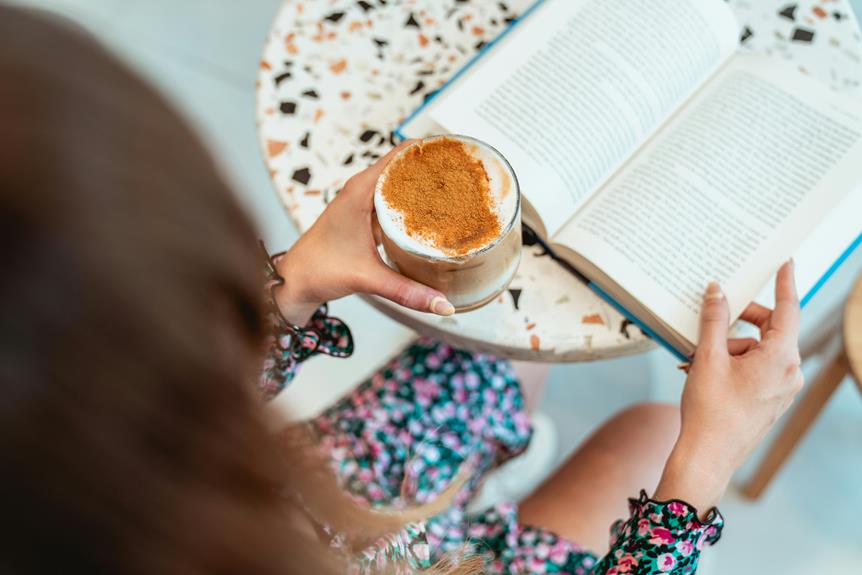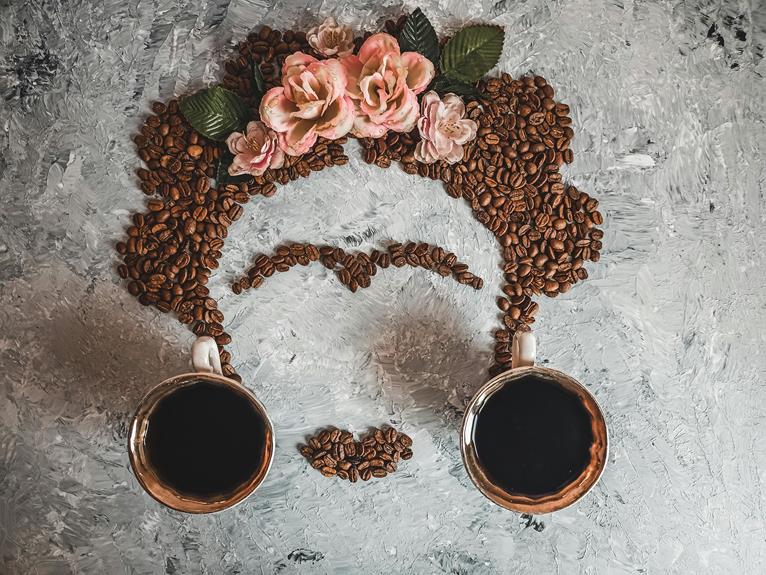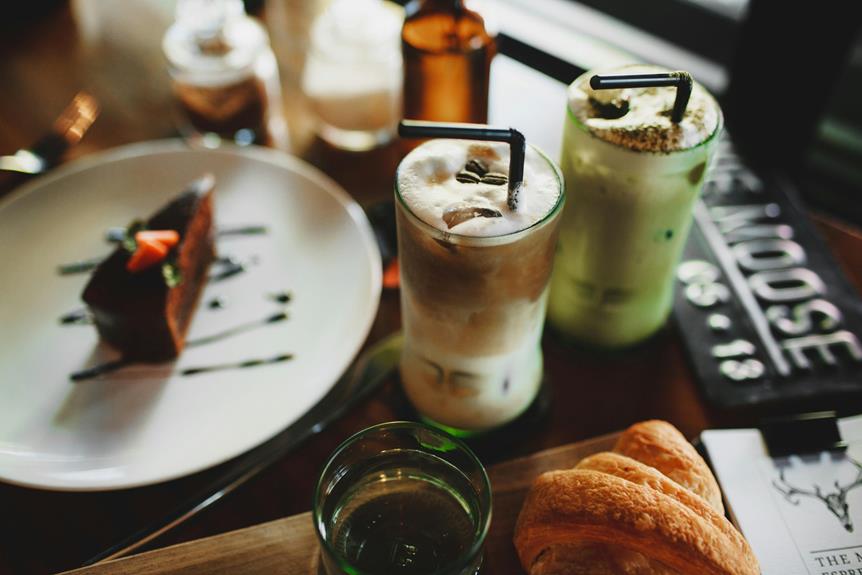You've probably seen those Instagram-worthy cold foam cold brew drinks with their mesmerizing swirls and tantalizing flavors. But what's the buzz about? Cold foam cold brew is a twist on traditional cold brew coffee, featuring a creamy, velvety topping made by whipping heavy cream and sugar. The result is a velvety smooth drink with a complex flavor profile, perfect for hot summer days. As you explore this trend, you'll discover a unique and revitalizing drink that's worth trying – and there's more to uncover about this indulgent treat.
Key Takeaways
- Cold foam cold brew is a unique coffee trend that combines cold brew coffee with a creamy, velvety topping made from whipped heavy cream and sugar.
- The drink features a complex flavor profile with notes of chocolate and caramel from the cold brew, balanced by the sweetness of the cream.
- Whipped coffee, including cold foam cold brew, has gained popularity on social media due to its visually appealing presentation and customizable flavors.
- The science behind cold foam involves air incorporation and fat molecule alignment, creating a smooth, creamy texture that can be manipulated by adjusting the ratio of air to fat molecules.
- To make cold foam cold brew, brew a strong cold brew coffee, whip heavy cream with sugar and vanilla extract, and combine the two, topping with the reserved foam.
What Is Cold Foam Cold Brew?
Sipping on a cold brew coffee drink, you've probably encountered a creamy, velvety topping that adds a luxurious touch – this is cold foam cold brew, a delightful twist on traditional cold brew coffee.
This innovative drink has taken the coffee culture by storm, offering a unique flavor profile that's both rich and revitalizing.
The cold foam is created by whipping heavy cream and a touch of sugar until it becomes light and airy, then topping it with a shot of cold brew coffee.
The result is a velvety smooth drink that's perfect for hot summer days.
The flavor profile is complex, with notes of chocolate and caramel from the cold brew, balanced by the sweetness of the cream.
As you take a sip, the creamy foam dissolves, releasing a burst of flavor that's sure to delight even the most discerning coffee connoisseur.
Whether you're a coffee aficionado or just looking for a new drink to try, cold foam cold brew is definitely worth a shot.
The Rise of Whipped Coffee
As you venture into the world of coffee trends, you can't help but notice the sudden popularity of whipped coffee, which has taken social media by storm with its mesmerizing swirls and tantalizing flavors. This trend is more than just a pretty face, though – it's a cultural phenomenon that's changing the way we think about coffee.
Visual appeal: The velvety texture and artistic swirls of whipped coffee make for Instagram-worthy photos that are impossible to resist.
Customization: Whipped coffee allows you to get creative with flavors, toppings, and presentation, making each cup a unique experience.
Social sharing: Social media platforms have played a significant role in popularizing whipped coffee, with users sharing their creations and experiences, thereby fuelling the trend.
The cultural significance of whipped coffee lies in its ability to bring people together, spark conversations, and create a sense of community. As you join the whipped coffee craze, you're not just sipping on a drink – you're part of a larger movement that's redefining the way we enjoy coffee.
Cold Brew Vs. Cold Foam
You're likely wondering what sets cold brew apart from cold foam, two coffee trends that are often mentioned together but have distinct differences.
The main distinction lies in their brew methods. Cold brew involves steeping coarse-ground coffee beans in cold water for an extended period, usually 12-24 hours, resulting in a smooth, low-acidity flavor.
On the other hand, cold foam is made by whipping heavy cream with a bit of sugar and vanilla extract, then topping it with cold brew or espresso.
The flavor profiles of these two coffee trends also vary notably. Cold brew has a rich, velvety texture and a sweet, chocolatey flavor.
In contrast, cold foam has a light, airy texture and a sweet, slightly tangy taste.
When combined, the cold brew provides a strong coffee flavor, while the cold foam adds a creamy, indulgent touch.
Understanding these differences will help you appreciate the unique characteristics of each trend and enjoy them in harmony.
The Science Behind the Foam
As you venture into the world of cold foam, you might wonder what makes it so velvety and whipped. Two key factors – air incorporation and fat molecules – come together to create the velvety, whipped texture of cold foam.
When you froth milk, you're incorporating air into the mixture, which gets trapped by the fat molecules. This combination creates a smooth, creamy texture that's similar to microfoam.
As you explore this process, three key elements are at play:
Air incorporation: As you froth the milk, air bubbles get trapped, creating a light and airy texture.
Fat molecule alignment: The fat molecules in the milk align themselves around the air bubbles, creating a stable and smooth texture.
Texture manipulation: By adjusting the ratio of air to fat molecules, you can manipulate the texture of the cold foam to your liking, making it more or less dense.
Understanding the science behind cold foam can help you appreciate the complexity of this seemingly simple coffee trend. By mastering microfoam dynamics and texture manipulation, you can create the perfect cold foam to top your coffee drinks.
How to Make Cold Foam Cold Brew
Now that you understand the science behind cold foam, let's put that knowledge into practice and make a velvety-smooth cold foam cold brew that will elevate your coffee game.
To start, brew a strong cold brew coffee and pour it over ice in a glass.
Next, whip heavy cream in a mixer or blender until it becomes stiff and holds its shape. You're aiming for a silky foam texture that's not too stiff or too runny.
Add a pinch of sugar and a dash of vanilla extract to the whipped cream to enhance the flavor profile.
Now, it's time to combine the cold brew and whipped cream. Pour the whipped cream over the cold brew, holding back the foam with a spoon. This will create a layered effect that's both visually appealing and delicious.
Finally, top with the reserved foam and enjoy your velvety-smooth cold foam cold brew.
With these simple steps, you'll be well on your way to creating a coffee drink that's sure to impress.
Popular Cold Foam Cold Brew Recipes
From classic flavors to unique twists, several popular cold foam cold brew recipes have emerged as fan favorites, and we're about to explore the most sought-after ones.
You'll find that each recipe offers a distinct flavor profile, perfect for experimenting with coffee pairings to find your new favorite combination.
- Vanilla Sweet Cream: A classic cold foam cold brew recipe featuring vanilla-flavored cold foam, sweet cream, and a drizzle of caramel syrup.
- Mocha Chip: A chocolate lover's dream, with mocha-flavored cold foam, chocolate chips, and a sprinkle of cocoa powder on top.
- Cinnamon Sugar Rush: A sweet and spicy recipe with cinnamon-flavored cold foam, a sprinkle of cinnamon sugar, and a drizzle of honey syrup.
These recipes offer a great starting point for exploring the world of cold foam cold brew. Feel free to experiment with different flavor profiles and coffee pairings to create your own unique recipes. With these popular recipes as inspiration, you'll be well on your way to becoming a cold foam cold brew expert!
Where to Try Cold Foam Cold Brew
Try cold foam cold brew at popular coffee shops or cafes that have already mastered the art of this trendy beverage.
You'll find that many of these establishments have perfected their own unique recipes, so you can experience the drink in different ways. For instance, some coffee shops might use a lighter roast coffee to bring out the sweetness of the cold foam, while others might opt for a bolder roast to create a richer flavor profile.
If you're looking for a more urban vibe, head to city cafes that often feature cold foam cold brew as a signature drink.
These cafes usually have a trendy atmosphere, making them perfect for Instagram-worthy moments. You might even stumble upon limited-time offers or seasonal flavors that'll make your cold foam cold brew experience even more special.
Don't be afraid to ask your barista about their take on the drink or request customizations to suit your taste. With so many options available, you're bound to find your new favorite cold foam cold brew spot.
Frequently Asked Questions
Can I Use Cold Foam Cold Brew in Hot Coffee Drinks?
You're wondering if you can use cold foam in hot coffee drinks? Absolutely! The texture contrast and flavor enhancement it adds will elevate your morning routine, so go ahead and give it a try in your hot brew.
Is Cold Foam Cold Brew Suitable for Lactose Intolerant People?
You're lactose intolerant, huh? Well, isn't that just peachy! You'll be thrilled to know that cold foam cold brew can be made with dairy alternatives, offering non-dairy options that'll make your taste buds (and tummy) happy.
Can I Add Flavorings to My Cold Foam Cold Brew?
You can absolutely customize your drink by adding flavorings! Experiment with different flavor profiles by mixing and matching syrup options, like vanilla, hazelnut, or caramel, to create a unique taste that suits your palate.
How Long Does Cold Foam Cold Brew Last in the Fridge?
Your freshly brewed coffee is like a delicate flower, requiring gentle care to stay fresh. Typically, it'll last 3-5 days in the fridge, but with proper storage tips, like airtight containers and minimal exposure to light, you can savor the flavor for up to a week.
Is Cold Foam Cold Brew More Expensive Than Regular Cold Brew?
You'll likely pay more for cold foam cold brew due to the added coffee markup and higher brewing costs, which can increase the price by up to 20% compared to regular cold brew.
Conclusion
You've frothed your way through the fascinating world of cold foam cold brew, where velvety textures and vibrant flavors converge.
Now, it's time to savor the sweet success of this scintillating sipper.
Silky smooth, subtly sweet, and sumptuously rich, cold foam cold brew is the perfect pick-me-up to perk up your palate.
So, go ahead, indulge in this creamy coffee craze and let the delightful drama of flavors unfold.

